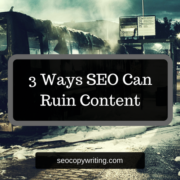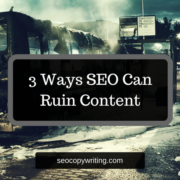How to Write High-Ranking Copy for Your One-Page Site
 Welcome back! In this week’s web-writing video tip, Heather addresses a question that she’s been asked repeatedly in the past week: “How can I write high-ranking copy for my one-page site?”
Welcome back! In this week’s web-writing video tip, Heather addresses a question that she’s been asked repeatedly in the past week: “How can I write high-ranking copy for my one-page site?”
You may be wondering why you would even want a one-page site, thinking “wouldn’t I just want to build out more content to the site?” And in most cases, yes, you would. But some companies decide on a one-page site for various, specific reasons, which Heather explains.
Of course, the biggest challenge of having a one-page site in the post-Panda SEO world is being found and ranked well in the search engines. So tune in as Heather discusses how you can optimize your single-page site with four specific strategies…
Many companies have one-page sites
- Direct response sales pages
You probably have seen a one-page site that is essentially a very long direct sales letter. The purpose of that page is to get you to buy something or to sign up for something – and the site itself is just that one page.
- Lead generation pages
You may also have encountered a one-page site if you’ve searched for something like car or home insurance. These are often lead generation pages that have their own separate domain name/URL, and where the sole purpose of the site is to collect your contact information.
- Home pages (and the rest of the content is behind a firewall)
This third scenario is one in which the site technically isn’t just one page. There may be hundreds or even thousands of additional pages on the site, but all the yummy, meaty content is behind a firewall.
With this type of site – where all the “goodies” are reserved for paying members – the only page visible to “non-members” and the search engines is the home page.
In this scenario, the only page the site owner has to work with for optimization is the home page.
So if you have a one-page site that suits your purposes, that’s cool…
But here’s the challenge…
- The search engines reward resource sites…and one-page sites aren’t considered a resource.
Resource sites are larger (than one page) sites that go in-depth about a particular topic, and one-page sites don’t fit that description. They are not considered a resource – no matter what.
- You can tweak the content until you’re blue in the face…but it won’t position.
For example, if you have a one-page site about “internet marketing” and you pit that site against all the thousands of other sites out there that have multiple pages dedicated to internet marketing, your site is not going to position – no matter what you do, and no matter how many times you tweak the content.
In order to position that one-page site, you will have to do more to it…
So what can you do?
- Can you make the one-page site part of your main site?
What a lot of companies do when faced with this SEO dilemma is rather than having that one-page site as a separate domain, they incorporate that landing page into their main site.
This is a really easy workaround. This way, you’re not marketing two separate domains, and you’re not worried about two domains: everything is happening on your one main site.
- Can you build out the site with informative, keyphrase-rich content? (This will take some time).
Now if you’d rather not go with option #1 (above) because you have an awesome domain name for your one-page site and you want to do more with it, you can just go the traditional route of building out more content.
That way, you’ll build relevancy for your single-page site, and you will see not only a search engine ranking boost, but also more people sharing your content – because there’s more content to share!
The flip side is that it’s going to take some investment of time as you’ll be writing a lot of content as you build out the site.
- Can you make any of the password-protected content public?
If you have a membership-exclusive site, or a similar situation where the majority of the content is password-protected, then the best-case scenario is if you can pull some of that content out to your home page so it is accessible both to non-members and the search engines.
Granted, you’d still have the “meat” of the content behind a firewall, but you’ll have more content that the public can look at and the search engines can work with.
This is actually a great way to work with conversions off of membership site: non-members can get a little taste of what they’d get in the way of content if they were to sign up for member status, and that can encourage them to convert a bit faster.
- If worse comes to worse…what other ways can you drive traffic to your one-page site?
Finally, if none of the above strategies appeal to you, and you want to keep that one-page site as it is, then consider other ways to drive traffic to it.
It should be clear that traditional SEO via organic search is not going to work for you – but certainly there are other ways you can drive traffic and get the targeted visitors you want landing on your site. Explore social media, and all the other options available to you!
photo thanks to Danard Vincente











Heather, what’s your view on building the page into the main site and setting up a keyword-rich domain that routes directly to it? From cases I’ve seen, the second domain won’t have any value in natural search, but there’s still an advantage with PPC/social media conversion, as well as supporting offline. Do you see any value / downside in this?
You can…I know a number of folks who do that with PPC. The challenge is that you’re marketing two different domains. If that makes sense with your business model, cool. If not, I would recommend marketing your one (main) domain instead.
Thanks, James!
I have a bunch of multiple-page sites, and also this one 1-pager. The single page site indeed has trouble showing up in the SERPs, which is strange because it’s an exact match domain for the keyword.
I expanded the content a bit and added another image. Hopefully that helps. My next step will be to add some additional pages – contact, disclaimer, FAQ, and maybe a videos page.
Great Post. It brought up a lot of issues that I hadn’t considered before. I honestly never realized the possibilities there were even with one page sites. Thanks!
For SEO, you don’t want to keep all of your content password protected. The search engines will find it more difficult to understand what your site is about and therefore won’t rank it prominently. In addition, this limits the number of target audience members that see what you have to offer. It’s OK to have some content protected, but not all of it should be hidden away.